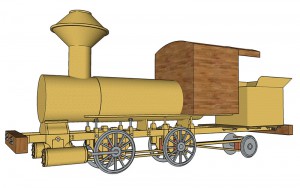A few weeks ago, I re-read my construction diary over at the railroad-line.com forums. Doing that I noticed that I failed to implement all of Thayer’s suggestions into my drawings. Most importantly the stack’s dimensions were too big while the boiler was too small in diametre.

In order to finally implement these adjustments and even more importantly in order to get a better feel for the loco as a whole, I set out to complete the 3D drawing as soon as possible. To that end I’m using a lot of placeholders. In this version, boiler, cab and tender are 100% dummies. Nevertheless one can already recognize the overall dimensions quite easily.
I’m hoping to get a lot of feedback, which in turn will help me to replace those dummies one after another by actual construction parts.
In the meantime I also continued work on the chassis. The drivers look good right now, therefor I’m focusing on the trailing wheel.

Hello
is it known how fast the Dewey Brothers Locomotive was able to travel with its oscillating cylinders.
Hello Doug,
welcome and thank you for your question!
I’ve re-read the two magazine articles that I have used in research on the Dewey Bros. loco, but they don’t give specifics.
The Railway and Locomotive Historical Society Bulletin No. 112 states on page 57: “In operation the cylinders on the low-wheeled locomotive rocked wildly, and the arrangement limited speeds to low figures.”
Likewise, Model Railroader May 1976 (No. 51) reports on page 46: “This [oscillating] arrangement was acceptable for logging service, since the locomotives were operated at slow speeds and maximum cutoff most of the time.”
So I can’t give you specifics on this question, which bothers me quite a lot since it is very interesting for me, too. Since there are no hard facts that I know of, I resort to the following reasoning:
(1) Locomotives with oscillating cylinders were built for strength, not for speed. The articles mentioned above and Sinclair 1907, p. 509 support this assumption.
(2) Geared Locomotives were built for the same field of operation, and reached modest operating speeds. For example a Shay was expected to run at about 12 mph (ca. 20 km/h), see Libby Heritage Museum (In case the site goes down: PDF-Version).
(3) So I assume that a locomotive with oscillating cylinders should have had an operating speed of no more than 15 mph (ca. 24 km/h).
I very much hope you find this useful. Feel free to contact me again for any further questions. 🙂
Best Regards,
Frédéric
Thank you Frédéric
This locomotive has fascinated me since I first saw its photo. I hope to make a “live steam ” model of it.
I recently made a twin cylinder oscillating steam engine for a small car I am making. It has a 2.5 inch (6.35cm) bore and 3.75 inch (9.5 cm) stroke.